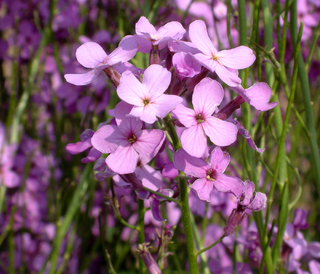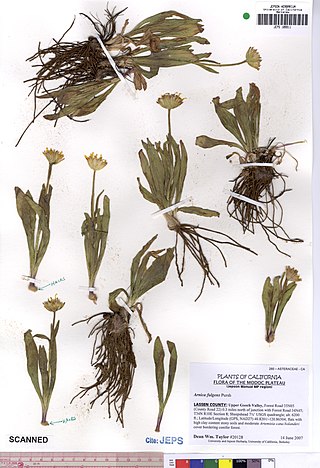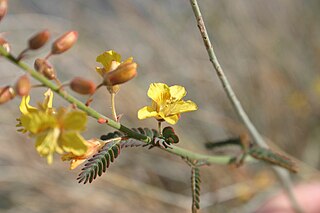
Hesperis matronalis is an herbaceous flowering plant species in the family Brassicaceae. It has numerous common names, including dame's rocket, damask-violet, dame's-violet, dames-wort, dame's gilliflower, night-scented gilliflower, queen's gilliflower, rogue's gilliflower, summer lilac, sweet rocket, mother-of-the-evening, Good & Plenties, and winter gilliflower.

Tripleurospermum inodorum, common names scentless false mayweed, scentless mayweed, scentless chamomile, and Baldr's brow, is the type species of Tripleurospermum. This plant is native to Eurasia and North Africa, and introduced to North America, where it is commonly found in fields, fallow land and gardens.

Cleomella is a small genus of about ten species of flowering plants. Like their relatives, the cleomes, plants of this genus have traditionally been included in the caper family Capparaceae but have recently been moved into a new family, Cleomaceae. Cleomella are annual wildflowers native to the dry and desert regions of western North America. They are similar to cleomes in appearance. They are erect and branching with leaves divided into three leaflets and inflorescences of yellow flowers with long stamens. Cleomella species are known commonly as stinkweeds or simply cleomellas.

Oreocarya confertiflora is a species of wildflower in the family Boraginaceae known by the common names basin yellow catseye and Mojave popcorn flower. This is a common desert plant native to the southwestern United States. It is an erect perennial herb approaching half a meter in height. The stems grow from a woody caudex and form a rough clump of hairy, bristly gray-green leaves in dry, rocky areas. Out of the clump grow erect stems topped with dense inflorescences of hairy mustard-yellow flowers. Each flower is tubular with sepals wrapped around the tube below a flat-faced or curled-back corolla of five lobes. The fruit is a nutlet 3 to 4 millimeters wide.

Gilia cana is a species of flowering plant in the phlox family known by the common name showy gilia. It is native to California and Nevada where it grows in open areas with gravelly and sandy soils, such as desert and rocky slopes. The Mojave Desert range of some subspecies may extend into Arizona.

Alopecurus aequalis is a common species of grass known as shortawn foxtail or orange foxtail. It is native to much of the temperate Northern Hemisphere from Eurasia to North America. It is most commonly found in areas near fresh water, such as the margins of ponds and ditches.

Arnica fulgens is a species of arnica known by the common names foothill arnica and hillside arnica. It is native to western North America, from British Columbia east to Saskatchewan and south as far as Inyo County, California, and McKinley County, New Mexico. It grows in open, grassy areas.

Artemisia nova is a North American species of sagebrush, known by the common name black sagebrush. It is "one of the most common shrubs in the western United States".

Balsamorhiza sagittata is a North American species of flowering plant in the tribe Heliantheae of the family Asteraceae known by the common name Arrowleaf Balsamroot. Also sometimes called Oregon sunflower, it is widespread across western Canada and much of the western United States.

Hoffmannseggia microphylla is a species of flowering plant in the legume family known by the common name wand holdback. It is native to the southwestern United States and Baja California and grows in gullies, canyons, slopes and primarily creosote bush scrub.

Calochortus panamintensis is a rare North American species of flowering plants in the lily family known by the common name Panamint mariposa lily. It is native to Inyo and Kern Counties in California, plus adjacent Nye County, Nevada. It is named after the Panamint Range near Death Valley.
Cleomella brevipes is a species of flowering plant in the cleome family known by the common name shortstalk stinkweed. It is native to the Mojave Desert and adjacent hills, where it grows in wet alkaline environments such as mineral-rich desert hot springs. It is an annual herb producing a rough, waxy, red stem up to about 45 centimeters tall. The stem is lined with many small fleshy leaves, each divided into three leaflets. Flowers appear in the leaf axils all along the stem, often all the way down to the base. Each grows at the end of a short, erect pedicel. The flower has four tiny yellow sepals and four tiny yellow petals. The fruit is a somewhat rounded, hanging capsule developing at the end of the remaining flower receptacle.
Cleomella parviflora is a species of flowering plant in the cleome family known by the common name slender stinkweed. It is native to eastern California and western Nevada, where it grows in desert and sagebrush scrub in the Mojave Desert and southern parts of the Great Basin. It is an annual herb producing a smooth, hairless, reddish stem up to about 45 centimeters tall. There are a few leaves, each made up of three elongated, fleshy leaflets. Most of the flowers are located in a raceme at the tips of the stem branches, and there may be a few solitary flowers in the axils of the leaves. Each flower has four tiny pale yellow petals, each about 2 millimeters long. The fruit is a lobed, valved capsule which hangs on the tip of the remaining flower receptacle.

Cleomella plocasperma is a species of flowering plant in the cleome family known by the common name twisted cleomella and alkali stinkweed. It is native to the Great Basin and Mojave Desert in the western United States, where it grows mainly in wet, alkaline soils such as those around hot springs. There is a disjunct population in the Bruneau Valley of southwestern Idaho. It grows with other halophytic species such as saltgrass and greasewood. This is an annual herb producing a smooth, hairless stem which divides into several erect or upright branches which may exceed half a meter tall. The sparse leaves are each split into three narrow leaflets. The flowers occur in a raceme at the top of each stem branch. Each flower has four yellow petals and several long stamens which may be over a centimeter long. The fruit is a capsule with large lobes. It hangs at the tip of the remaining flower receptacle.

Eriogonum brachyanthum is a species of wild buckwheat that is commonly known as shortflower buckwheat. It is native to eastern California and western Nevada, particularly the Mojave Desert region, where it is common to abundant, and even sometimes weedy. It is also known from southern Oregon. The plant grows in sandy habitats such as desert flats and sagebrush. It also grows in pinyon-juniper and montane conifer woodlands. It is an annual herb that grows 30 to 40 centimeters tall. Leaves are located at the base of the stem, woolly, and oval or rounded in shape. The top of the stem is occupied by a branching inflorescence bearing many widely spaced clusters of flowers. Each individual flower is about a millimeter wide and light yellow in color. Flowers bloom from April to November.

Eriogonum contiguum is an uncommon species of wild buckwheat. It is commonly known as Reveal's buckwheat and annual desert trumpet. It is native to Death Valley in California and adjacent sections of Nevada. It is commonly found in Death Valley National Park and Mojave National Preserve. Eriogonum contiguum grows in sandy to gravelly flats and slopes, or rocky hills, and lower bajadas with Atriplex species. It is an annual herb which produces an erect, spreading stem up to about 30 centimeters high. Leaves are basal, small rounded, and woolly. The many scattered inflorescences are small, compact clusters of tiny hairy yellow flowers. Flowers bloom April to June. It is threatened due to habitat degradation by off-road vehicles, competition with exotic plant species, trampling, grazing, and erosion.

Ranunculus eschscholtzii is a species of buttercup flower known by the common name Eschscholtz's buttercup.

Erigeron poliospermus is a species of flowering plant in the family Asteraceae known by the common names gray-seeded fleabane and purple cushion fleabane. Native to western North America, it is mainly found to the east of the Cascade Range in Washington, Oregon, and Idaho.

Ranunculus hispidus is a species of perennial flowering plant in the buttercup family, Ranunculaceae. It is commonly known as bristly buttercup or hispid buttercup. It is a small plant native to central and eastern North America that grows to a height up to 30 cm (1 ft) and has 5-petaled yellow flowers.

Rumex fueginus, known as American dock, golden dock, and Tierra del Fuego dock, is a flowering plant in the family Polygonaceae. Rumex fueginus was first formally named by Rodolfo Armando Phillipi. Rumex fueginus is native from Canada in northern North America to Tierra del Fuego at the southern tip of South America. It has previously been considered a subspecies or variety of Rumex maritimus, a Eurasian species.


















